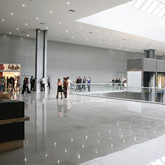
Transport Sector
The transport Sector has very specific demands regarding materials and design finishes. Due to the very high traffic, flow safety is paramount no matter what the weather conditions or emergency. Avant Flooring was developed in Germany with a focus on solving the challenges faced by the transport sector. First, adding a slip resistant layer for everyday use, then a design that enabled a high load bearing capacity and an extremely high fire resistance, ensuring users’ safety in the event of an emergency. The longevity and sustainability are also a major requirement. Avant Flooring solves this by the use of a specialised material composition, columnar honeycomb structure as well as unique lamination layers and construction techniques.
Sector Challenges
High load bearing capacity:
High traffic environments require flooring products that can stand up to daily wear-and-tear, without creating visible wear patterns. If fast wear and tear occurs, there will be high maintenance costs incurred, possibly even leading to replacement. Avant Flooring has a columnar honeycomb structure, which allows for high load bearing capacity and has the added benefit of improved sound reduction from the large number of people passing over it. Avant Flooring is also made with lamination layers giving it exceptional impact resistance and significant abrasion resistance. These are all certified to the highest standard by SGS and ensure the longevity of Avant Flooring within the transport sector, whether it be for bus, train, metro or subway stations.
Composite Materials:
Avant Flooring uses a multitude of materials to create a well-functioning composite structure. When developing the composition in Germany, it was a priority that everything had to be highly sustainable and guarantee additional benefits to the end product. The final composition allows for increased durability, chemical resistance and strength compared to its wood counterparts, as well as being 100% waterproof.
Safe:
With such a large amount of users within the public transport sector, health and safety must be the highest priority. Avant Flooring was developed with this in mind, ensuring extreme fire resistance in the unfortunate event of a fire. Avant Flooring is also fitted with an anti-slip layer, which increases friction and stops individuals slipping and injuring themselves, even if water is present.
Large variance in temperature resistance:
With stations around the world having a vast range of environments and temperatures, the same flooring may not be suitable for everywhere. With the many advanced functions of Avant Flooring, including its impressive scope of resistance, between -20 degrees Celsius to +80 degrees Celsius, permits usage in both hot and dry countries, such as the UAE, and cold and wet countries, such as Germany, with no risk of expanding or warping due to the weather conditions; ideal all interior.
Fast Installation:
Any closure of stations or terminals would lead to a loss of revenue and disruption to peoples’ travel around a city or country. Knowing this, Avant Flooring incorporated a tongue-and-groove lock into the design, which enables incredibly fast installation; no more than 8 minutes per square m. This guarantees that no more than a miniscule timeframe is needed for installation/reinstallation, ultimately saving on labour costs.
Multitude of Colours:
Different transport stations should have their own unique design. Avant Flooring utilises a colour layer allowing 15 different colours and grains to compliment any current or new design trends. Should part of the station be in direct sunlight, colours under normal circumstances would begin to fade. Avant Flooring ensures the longevity of their products with an ultra violet resistance layer with grade 5 colourfastness, as assessed by international standard authorities.
Sustainable and Energy Saving:
If public stations and terminals use ineffective insulating materials, the country and population will incur high financial cost due to excessive energy consumption. Avant Flooring offers a reduction in utility bills of between 15-30 percent, reducing carbon footprint while increasing savings. This is due to the highly advanced columnar honeycomb structure having small air pockets that create high thermal insulation.







